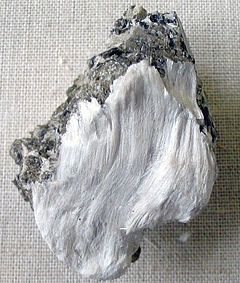When starting a new renovation there are three words you definitely do not want to hear: “We found asbestos.” While many of us know to be afraid of asbestos exposure, we may not know what having asbestos in our homes fully entails. We consulted with Robert Timm of Templar Mould / Asbestos Analysis and Removal to help answer your asbestos questions should you hear those three words during your next renovation.
What Is Asbestos?
In the 20th century, asbestos became a widely used building material, praised for its low cost, fire resistance and sound absorption. It wasn’t until the latter half of the century that asbestos was marked as a high-risk material and was discovered to be linked to severe health issues. While Canada is set to ban asbestos and asbestos-containing products by 2018, it is still found in many older homes that were built when asbestos was a commonly used product.
Asbestos is generally safe if left undisturbed, the real danger comes once the asbestos is disturbed which causes it to break and release particles into the air. These tiny abrasive asbestos fibers are easily inhaled which damages lung tissue and can cause cancer.
The Most Common Places For Asbestos
Before you begin your next renovation, it is important to know where asbestos can be hiding. The most common places include:
 Insulation materials for pipes and furnaces, and attic insulation
Insulation materials for pipes and furnaces, and attic insulation- Asbestos and cement shingles
- Siding and roofing tiles
- Soundproofing applications
- Plaster and joint compounds
- Some plastics, including paints and adhesives
- Casings for electrical wires
- Some floor tiles and flooring adhesives
If the asbestos is found to be in good condition, it will not release dangerous fibers into the air, however, disturbing it may lead to health issues. The best thing to do with asbestos material in good condition is to leave it alone. Should your renovation reveal there is asbestos in your home, whether in good condition or poor, you will need to take proper steps to ensure that it is handled correctly.
What To Do If You Find Asbestos
There are two things that can be done if asbestos is found: repair or removal. Repairing means the asbestos is either sealed off or covered to ensure it does not break apart. While repairing is usually cheaper than removal, should you need to remove the asbestos completely later on, it will make the removal of asbestos more difficult and expensive.
We strongly recommend you do not try to repair the asbestos on your own. Improper handling of asbestos materials creates more problems than it solves. This is why removal by a professional is the preferred method. The decision is up to you, but remember, both options will require a properly licensed and trained professional.
Robert notes that if the asbestos found in your home is in a friable or possible friable state (meaning that one can easily crush the asbestos material in one’s own hand), then removal should be considered. “This decision can only be made by a certified asbestos abatement company. Once asbestos has been identified or analyzed by a trained consultant (IAC2 certified) by means of physical bulk analysis performed at a certified laboratory using the proper polarized microscopes, the asbestos abatement can proceed.”
Robert ensures that the discovery of asbestos should not cause you to stop your entire renovation plans. “No renovation needs to be avoided because of asbestos being present in any building materials in the home. The asbestos must first be abated by a certified company first following all regulations under Asbestos Reg. 278/05 before the home renovation may begin. Asbestos is only used today in transit pipe used in commercial building construction.”
Tips For Hiring An Asbestos Specialist
While finding asbestos is not the absolute worst thing that can happen in a project, it still needs to be handled carefully and properly. If you’re looking to hire a pro for your asbestos removal, there are a few things to consider.
Robert recommends asking the contractor to produce proper asbestos training certificates that have been issued to all company employees through The Ministry of Colleges & Universities. The company should also carry liability insurance and have all their workers covered under WSIB (tip: ask for the WSIB number). It’s a good idea to also ask the contractor how many years experience they have removing asbestos.
While asbestos was once a widely used material that has led to many illnesses, if it is found in your home, it does not mean your dream renovation has to be stopped completely. By hiring a trained professional and taking the proper steps, finding asbestos in your home renovation can be dealt with correctly and easily.
Article updated on June 4, 2019.
